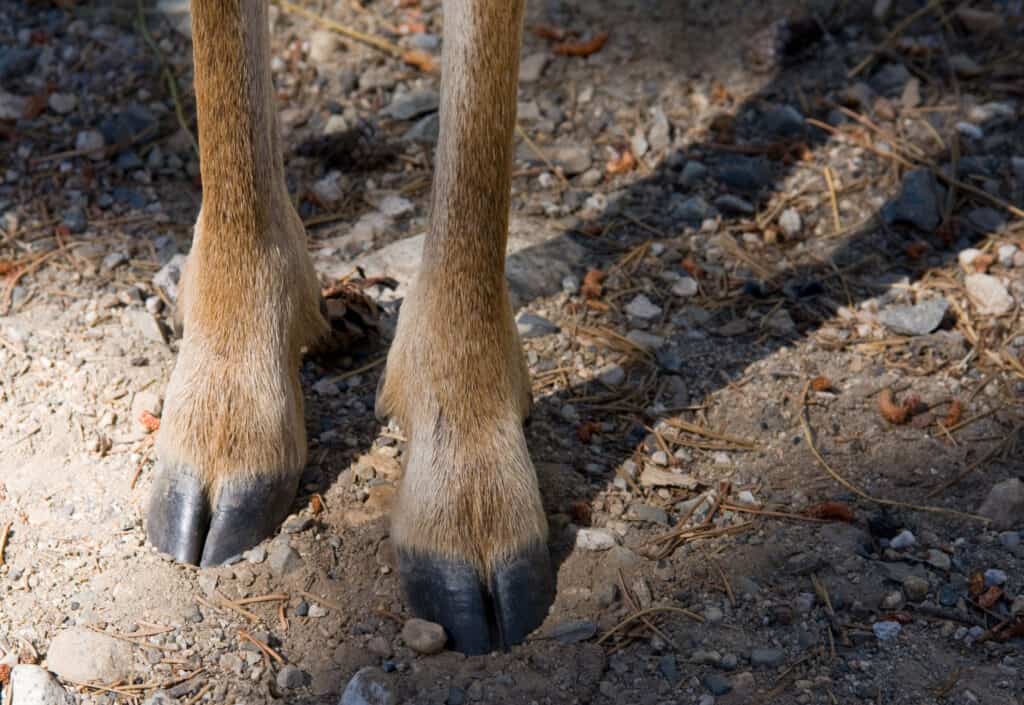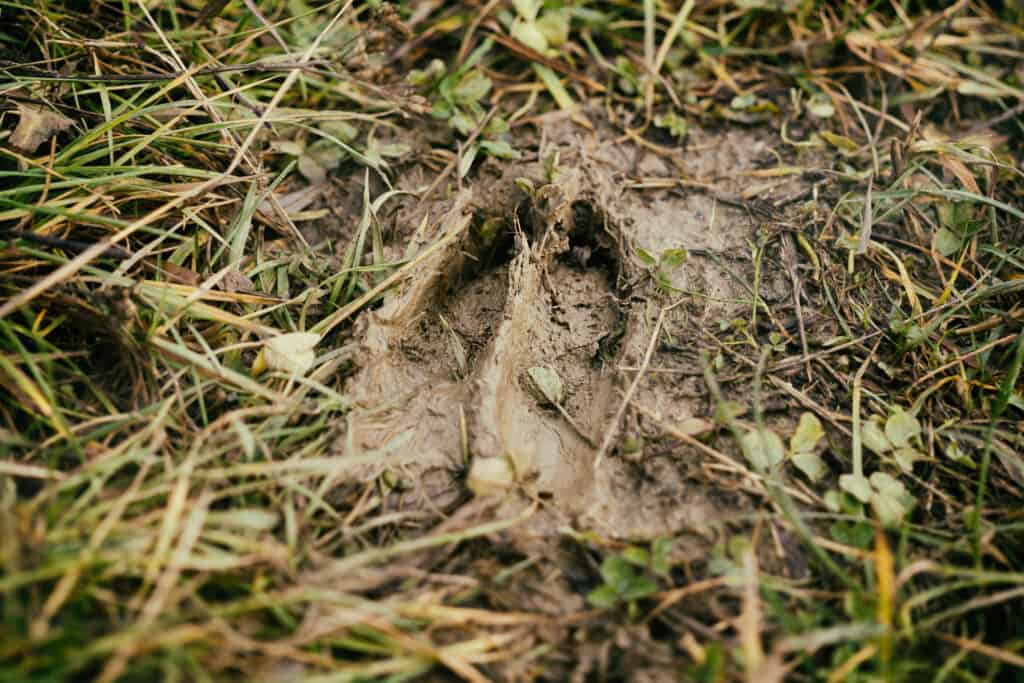If you want to distinguish deer footprints from other animals’ footprints, then you must learn everything about their hooves. What are they, how do they help deer in the wild, and what tracks do they leave? Keep reading to find out the answers!
What Are Deer Hooves?

Deer hooves are toe tips covered by keratin.
©iStock.com/epantha
Deer are even-toed ungulates, meaning they walk on two main toes. Deer hooves are toe tips covered by keratin. They are very important for deer because they support their weight, protect the bones and tissues inside the hoof capsule, and give them traction.
Hooves consist of four layers: stratum externum, stratum medium, stratum internum, and dermis parietis.
Together, deer hooves make up a cloven hoof. Besides the two main hooves, deer also have something called “dewclaws,” which are slightly smaller and aren’t usually used for walking.
If you have a cat or a dog, you probably know the fifth digit on their paws, which does not touch the ground and doesn’t hold the animal’s weight. Well, that digit is a dewclaw.
Deer dewclaws, however, may touch the ground during jumping or running, especially if they do so in mud or snow.
What Are Deer Hooves Good For?

Deer often use their hooves to defend themselves against predators like coyotes, wolves, or bears.
©iStock.com/Elizabeth Lara
As already stated, hooves are extremely important parts of a deer’s body. They help their owners run, jump, swim, and defend themselves.
Running and jumping with the help of the hooves is much easier, especially when deer try to escape a predator. While they primarily use their hind leg muscles for running, their hooves help them take rapid turns and push off while jumping. Moreover, since the hooves are made from keratin, they’re more durable than bones, which can crack. Therefore, deer can easily rely on their “feet.”
Another interesting fact is that hooves allow deer to walk quietly and avoid making too many sounds, thus keeping possible predators away.
Moreover, deer often use their hooves to defend themselves against predators like coyotes, wolves, or bears. They sometimes use their hind legs and hooves to strike the animal threatening them.
Besides the above, deer have interdigital scent glands between their hooves which help them track each other.
On the other hand, as helpful as they can be in some situations, hooves do not protect deer from ice-covered roads. The animals may slip, fall, or be defenseless.
Do Deer Hooves Fall Off?
Yes, deer hooves sometimes fall off, unfortunately. Hoof sloughing is linked to a chronic form of hemorrhagic disease. This health issue is considered the most threatening infectious disease in white-tailed deer. It is caused by the viruses in the Orbivirus genus and can be transmitted through biting midges in the Culicoides genus, primarily the Culicoides variipennis species. The symptoms depend on whether the disease is in its peracute, acute, or chronic stage. The first is the most challenging and can kill the animal within 24 hours.
If the disease is in a chronic stage, deer hooves may be ringed or broken. Some hooves may even fall off.
What Other Animals Have Hooves?
Did you know that deer aren’t the only lucky animals to have hooves? Pigs, giraffes, some horses, sheep, goats, cattle, bison, pronghorns, rhinoceroses, and tapirs are only some of the animals that walk on hooves.
Dewclaws, on the other hand, are present in many more animals, including birds, reptiles, and even dogs and cats.
Dog dewclaws are located on the inside of their front legs and, in some species, on their hind legs. Some dogs have two dewclaws on each leg. They are called double-dewclawed individuals.
Cats and other felids living in the wild have dewclaws, too. Wild animals use them in hunting, catching, and holding prey.
How To Identify Deer Footprints?

Deer most often leave behind upside-down “broken” heart-shaped tracks.
©iStock.com/Valeria Vechterova
If you live in an area where no other even-toed ungulates or hoofed mammals live, identifying deer tracks is extremely easy, thanks to their hooves’ unique shape. However, if the habitat hosts other animals like them, you’ll have to examine the tracks carefully to understand which belongs to which animal.
So what do deer tracks look like? The track’s sides are convex, and the front tips are located towards the inside part of the track. Deer most often leave behind upside-down “broken” heart-shaped tracks.
Let’s see how to distinguish deer hooves from other animals’ hooves!
Deer Tracks vs. Bighorn Sheep Tracks
Distinguishing between deer and bighorn sheep tracks is pretty easy because they look completely different. While deer leave upside-down heart-shaped tracks, Ovis canadensis tracks are wedge-shaped. The front tips are less pointed than a deer’s, and the track sides are straight.
Deer Tracks vs. Pronghorn Tracks
For the inexperienced eye, deer tracks look almost the same as pronghorn tracks because they have similar sizes and upside-down heart shapes. Furthermore, the front hoof tips are also toward the inside of the track.
The main difference stands for the sides of the track. While deer leave tracks with convex sides, pronghorns have hooves that mark the ground with concave-sides tracks. Moreover, pronghorns do not have dewclaws.
Deer Tracks vs. Wild Boar Tracks
Deer tracks and wild boar tracks look similar in shape. However, the latter is wider and more rounded. The hoof tips are blunt, and most wild boars leave dewclaw tracks, too.
Deer Tracks vs. Mountain Goat Tracks
Mountain goat tracks have a pear-like shape, and the distance between the hoof tips is larger, while the tips themselves are wider and more rounded.
Incredible Deer Facts
Here are some absolutely incredible deer facts to share with other animal enthusiasts!
- Did you know that deer can swim at speeds of up to 15 miles per hour? Well, the truth is, you might’ve already known that. But we bet you didn’t know that their hooves play a great role in gaining such speed!
- Deer have historically been a major symbol in religion, mythology, heraldry, and literature.
- Deer antlers are temporary and tend to grow back!
- The northern pudu measures 12.2 – 14 inches at the shoulder, weighs 7.25 – 14.25 pounds, and it’s the world’s smallest deer!
- Almost all male deer have antlers! The only exception is the water deer, which has tusk-like canines.
- Deer are believed to have been on Earth since the Early Oligocene, meaning their population is almost 40 million years old!
Up Next:
The photo featured at the top of this post is © iStock.com/Elizabeth Lara
Sources
- Kidadl, Available here: https://kidadl.com/facts/deer-hooves-why-they-have-split-feet-what-they-use-them-for-and-more
- Wildlife Start, Available here: https://wildlifestart.com/deer-hooves-facts/
- MDWFP, Available here: https://www.mdwfp.com/wildlife-hunting/deer-program/diseases-and-abnormalities/hemorrhagic-disease-the-white-tailed-deer/
- Our Endangered World, Available here: https://www.ourendangeredworld.com/species/interesting-deer-facts/
Thank you for reading! Have some feedback for us? Contact the AZ Animals editorial team.






